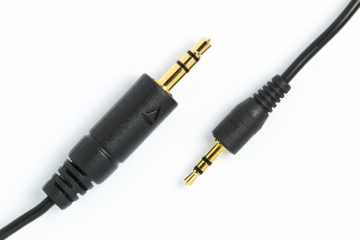How to Charge AirPods Without a Case
Discover the truth about how to charge AirPods without a case. Uncover myths, find alternatives, and safeguard your audio experience.

The only difference between 3.5mm and 1/4-inch jacks is the size. The 3.5mm plug is actually a miniaturized version of the 1/4-inch plug which was already in use.
There’s no actual difference in sound quality between the two. As I already stated, the only big difference is in the connection on the device. In this article, I will dive deeper into both jacks.
A 3.5mm jack is common in consumer electronics, while home or studio devices have the larger 1/4-inch jack. Let’s learn more about both and see which is better.
https://www.flickr.com/photos/30478819@N08/50689347692
As I already mentioned, the 3.5mm plug was made to downsize the larger 1/4-inch plug. Therefore, it’s a miniaturized version of the 1/4-inch plug which was already in use.
The 3.5mm plug is often a TRS jack (tip-ring-sleeve), also known as stereo unlike TP (tip-sleeve) or mono. They’re not the same in size, obviously but that doesn’t affect the sound quality.
Usually, home and stereo units feature the larger and more rugged jack (1/4-inch) because it’s harder to remove, providing stability and security when recording in a studio. If you are wondering how much a home recording studio would cost this 2021, check this article.
Watch This Video: 1/4-Inch And 3.5mm – Types Of Audio Jacks – Detailed Explanation
I already stated that there’s not a huge difference between 3.5mm and 1/4-inch jacks. However, they’re not completely the same. Therefore, let’s take a look at their differences.
The 3.5mm jack is about 1/8-inch. They’re often found in stereo. However, with 1/4-inch jacks, it varies. You can usually notice TS (mono) cables on guitar and instrument cables.
The 1/4-inch jack is a bit larger, sturdier, and less vulnerable to breaking. With 1/4-inch jacks, you have more choices to wiring it up, make better and stronger connections, and more.
There’s also more area for connections between the jack and the plug. If you’re not into portable audio, you would take amps or phones with 1/8-inch connections as a negative.
There’s no actual difference in the sound quality. As I already concluded, the only important difference is the size. Usually, portable units feature smaller jacks.
Home and studio units, on the other hand, have a larger jack. In my experience, the 1/4-inch jack isn’t as easy to remove, so it provides extra stability when recording in a studio.
However, if you’re into portable high-end players and amps, note that they feature the smaller 1/8-inch. Therefore, even with different currents, there’s not a sound difference.
It’s just that a 1/4-inch jack is sturdier, more stable, and honestly, more satisfying to plug in. I’ve asked a dozen people if they noticed any sound differences between the two.
And they’ve all answered that they haven’t noticed a difference. In fact, most higher-quality headphones include adapters, so the differences come from usability.
https://commons.wikimedia.org/wiki/File:Small_jack_plugs.jpg
The 1/8-inch jack is preferable in personal, portable electronics while the 1/4-inch jack is the main jack of choice for the music industry.
The reason why a 1/4-inch jack is a primary choice for home and studio devices is durability. Meaning, a 1/4-inch is less likely to bend and break.
The same doesn’t apply to small wires and jacks. I can’t remember how many 1/8-inch jacks I’ve broken over the years due to constant bending.
Furthermore, 1/4-jacks handle more power than 1/8-inch jacks. However, 1/8-inch jacks can do the trick if you’re using portable equipment.
Watch This Video: Audio Connectors – XLR, 1/4-Inch, 3.5mm, SpeakON, RCA, and More!
Typically, 1/4-inch jacks rule the music industry. They’re a common choice for line-level and instrument connections because they’re more durable, harder to unplug and provide stability.
You can easily tell if you have a 3.5mm jack by size. It’s almost 50% bigger than a 2.5mm jack. Other than that, they’re pretty similar. Usually, 2.5mm jacks have one ring extra.
https://www.pxfuel.com/en/free-photo-xshbd
Yes, the design of aux connectors and headphones jacks is usually the same (3.5mm or 1/8-inch TRS). So, you can plug a 3.5mm jack into anything that has a regular headphone connection.
It moves sound to the multimedia system, allowing you to play music from a unit via your car’s speakers. Aux is universal for audio while the headphone jack is suitable for headphones only.
Watch This Video: 5 Fun Facts About Aux Cables
The origins of the 6.35mm jack, also known as 1/4-inch jack trace back to old telephone switchboards. It also became popular for stereo headphones and musical instrument connections.
The wiring of a 1/4-inch is normally TS (tip-hot sleeve-ground) and TRS (tip-left ring-right sleeve-ground). The 1/8-inch jack, popularly known as the 3.5mm jack is a slightly smaller connector.
It gained a lot of popularity with walkie-talkies, early hearing devices, and the first compact radios to link the earbuds. In the ‘70s, Sony utilized the 3.5mm jacks as the headphone connection on their Walkman cassette players. Nowadays, you can spot these jacks on almost all portable devices.
The wiring is often TS (tip-hot sleeve-ground), TRS (left ring-right sleeve-ground), and TRRS (tip-left ring-right ring-mic and control sleeve-ground). They’re very common in compact devices.
However, which is better, 3.5mm or 1/4-inch jacks? Well, in my opinion, a 1/4-inch jack offers a stronger connection because they’re bigger. Therefore, they’re also more stable and durable.
Overall, 1/4-inch jacks can handle more beating. Therefore, they’re less prone to bending and breaking. Additionally, they enable more current to pass through them, if that matters to you.
However, this doesn’t make a difference in headphones since they don’t need a large amount of current flow anyway. That being said, it’s totally up to you and your needs on what you pick.
Was this helpful? If so, share it where you see fit and drop your questions and thoughts in the comment section! Let’s continue the discussion about the different audio connectors below!